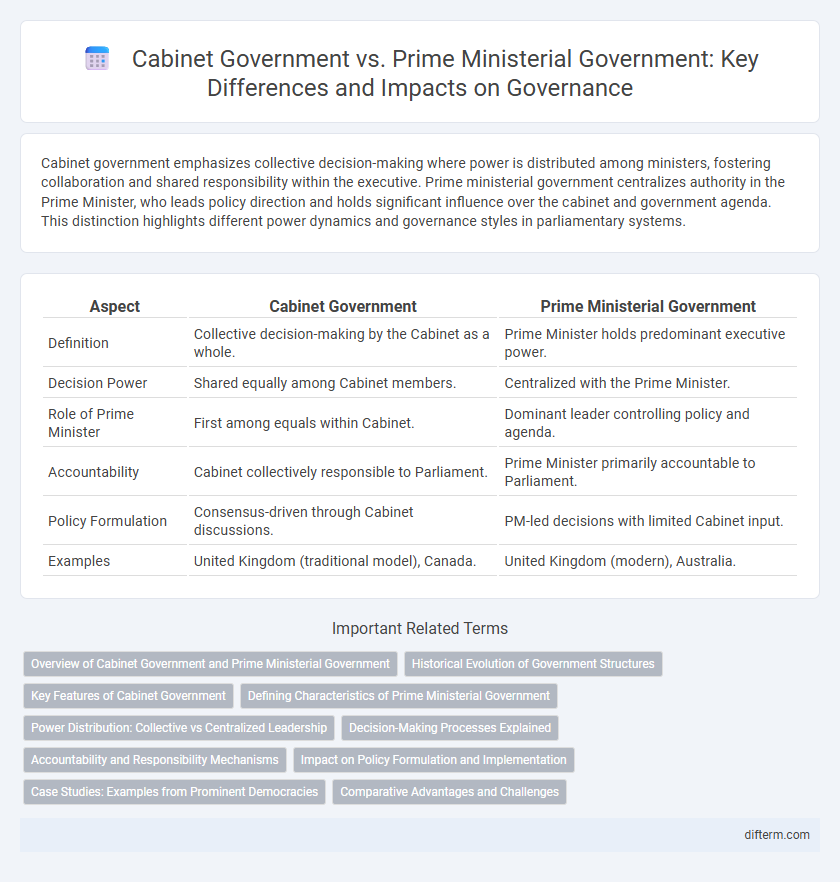Cabinet government emphasizes collective decision-making where power is distributed among ministers, fostering collaboration and shared responsibility within the executive. Prime ministerial government centralizes authority in the Prime Minister, who leads policy direction and holds significant influence over the cabinet and government agenda. This distinction highlights different power dynamics and governance styles in parliamentary systems.
Table of Comparison
| Aspect | Cabinet Government | Prime Ministerial Government |
|---|---|---|
| Definition | Collective decision-making by the Cabinet as a whole. | Prime Minister holds predominant executive power. |
| Decision Power | Shared equally among Cabinet members. | Centralized with the Prime Minister. |
| Role of Prime Minister | First among equals within Cabinet. | Dominant leader controlling policy and agenda. |
| Accountability | Cabinet collectively responsible to Parliament. | Prime Minister primarily accountable to Parliament. |
| Policy Formulation | Consensus-driven through Cabinet discussions. | PM-led decisions with limited Cabinet input. |
| Examples | United Kingdom (traditional model), Canada. | United Kingdom (modern), Australia. |
Overview of Cabinet Government and Prime Ministerial Government
Cabinet Government is a system where collective decision-making is central, with ministers holding equal authority in policy formation, ensuring balanced power distribution within the executive branch. Prime Ministerial Government emphasizes the dominance of the Prime Minister as the chief executive, concentrating decision-making power and leadership in one individual who directs government policy and coordinates ministerial activities. The distinction lies in Cabinet Government's focus on consensus and shared responsibility, contrasting with Prime Ministerial Government's centralized leadership and stronger executive control.
Historical Evolution of Government Structures
The historical evolution of government structures reveals that Cabinet Government emerged in the 18th century United Kingdom as collective ministerial decision-making gained prominence, replacing monarchical absolutism. By the 20th century, the Prime Ministerial Government model advanced, emphasizing centralized executive power within the Prime Minister's office, reflecting shifts toward stronger political leadership. This evolution highlights the transition from collaborative cabinet authority to a system where the Prime Minister wields significant influence over both policy and administration.
Key Features of Cabinet Government
Cabinet Government features collective decision-making with power distributed among cabinet members who represent various ministries, ensuring balanced representation within executive authority. The Prime Minister's role in Cabinet Government is primarily primus inter pares, or first among equals, emphasizing consensus and joint responsibility rather than unilateral leadership. This system promotes collaborative governance, accountability, and a unified policy approach through cabinet solidarity and collective ministerial responsibility.
Defining Characteristics of Prime Ministerial Government
Prime Ministerial Government is characterized by the concentration of executive power in the hands of the Prime Minister, who dominates policy-making and party leadership, often overshadowing the Cabinet. The Prime Minister controls the legislative agenda and exercises significant authority over appointments and government communication, enhancing centralization. This structure contrasts with Cabinet Government, where collective decision-making and equal ministerial influence are emphasized.
Power Distribution: Collective vs Centralized Leadership
Cabinet Government features collective leadership where decision-making power is distributed evenly among ministers, promoting consensus and shared responsibility. Prime Ministerial Government centralizes authority in the Prime Minister, enabling more decisive and streamlined policymaking. This concentration of power often results in a stronger executive leadership compared to the collaborative nature of Cabinet Government.
Decision-Making Processes Explained
Cabinet Government features collective decision-making where the cabinet members discuss and agree on policies, emphasizing consensus and shared responsibility. In contrast, Prime Ministerial Government centralizes decision-making authority in the Prime Minister, who often directs policy and controls cabinet agendas. This shift impacts the balance of power within the executive, influencing the efficiency and accountability of government actions.
Accountability and Responsibility Mechanisms
Cabinet Government emphasizes collective responsibility where all ministers share accountability for decisions, fostering a unified executive front and ensuring decisions are debated openly within the cabinet. Prime Ministerial Government centralizes authority in the Prime Minister, who holds predominant responsibility for policy direction and decision-making, resulting in focused accountability primarily on the Prime Minister. Mechanisms in Cabinet Government involve joint cabinet scrutiny and consensus, while in Prime Ministerial Government, accountability is often channeled through the Prime Minister's leadership and direct control over ministerial actions.
Impact on Policy Formulation and Implementation
Cabinet government distributes decision-making authority among collective ministers, promoting diverse input and consensus in policy formulation, which can slow implementation due to extended deliberations. Prime ministerial government centralizes power in the prime minister, enabling swift policy decisions and streamlined implementation but risks marginalizing other cabinet members, potentially reducing policy inclusivity. The choice between these systems directly affects the efficiency, responsiveness, and democratic accountability of governance processes.
Case Studies: Examples from Prominent Democracies
In Cabinet Government systems such as Australia and Canada, decision-making is characterized by collective ministerial responsibility and a strong emphasis on consensus within the Cabinet, ensuring balanced power distribution among ministers. Prime Ministerial Government models, seen prominently in the United Kingdom, centralize executive authority in the Prime Minister, who exercises substantial control over policy direction and Cabinet selection. Comparative case studies reveal that Cabinet Governments often foster collaborative governance, while Prime Ministerial Governments enable decisive leadership, impacting the effectiveness and stability of democratic administrations.
Comparative Advantages and Challenges
Cabinet Government centralizes decision-making within a collective body of ministers, promoting collective responsibility and diverse input, but can face slower policy implementation due to the need for consensus. Prime Ministerial Government concentrates executive power in the hands of the Prime Minister, enabling swift decision-making and clear leadership, yet risks marginalizing cabinet members and reducing checks on authority. Both systems balance efficiency and accountability differently, influencing governance stability and responsiveness in varying political contexts.
Cabinet Government vs Prime Ministerial Government Infographic

 difterm.com
difterm.com